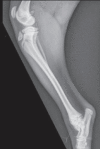Surgical and medical management in the treatment of proximal tibial metaphyseal fracture in immature dogs
- PMID: 35653377
- PMCID: PMC9162371
- DOI: 10.1371/journal.pone.0268378
Surgical and medical management in the treatment of proximal tibial metaphyseal fracture in immature dogs
Abstract
The purpose of this study was to report approaches to surgical and medical management of proximal tibial metaphyseal fractures (PTMF) and short-term case outcome. Medical records of immature dogs with PTMF were reviewed and data were collected including history, signalment and side affected. Data pertaining to surgical and medical management including radiographic evaluation and short-term complications were recorded. Forty-five dogs with a total of 47 PTMF identified and treated between 2007-2019 were included in this study. Six cases were managed with external coaptation alone. Forty-one cases were treated surgically with constructs including K-wires in different configurations, bone plate and screws, and external skeletal fixation. Of the cases managed conservatively, 4 developed complications, including bandage sores, diffuse osteopenia of the tarsus/metatarsus, and angular limb deformities. Surgical complications including pin migration necessitating removal, osteopenia, and screw placement in the proximal tibial growth plate or into the stifle joint were found in 16 cases. PTMF treated with surgery had a subjectively more predictable outcome compared to those treated with external coaptation alone. Conservative management may result in complications including development of excessive tibial plateau angle (TPA) as well as distal tibial valgus.
Conflict of interest statement
The authors have declared that no competing interests exists.
Figures











References
-
- Seamon J.A. and Simpson A.M. Tibial fractures. Clin Tech Small Anim Pract. 2005; 19: 151–167 - PubMed
-
- Gorse M.J. Using external skeletal fixation for fractures of the radius and ulna and tibia. Vet Med 1998; 93: 463–467
-
- Marretta S.M. and Schrader S.C. Physeal injuries in the dog: a review of 135 cases. JAVMA 1983; 182: 708–710 - PubMed
-
- Schmokel H. Weber U. and Hartmeier G. Salter-II fracture of the proximal tibia with avulsion of the tuberositas tibiae in the dog. Schwizer Archiv fur Tierheilkunde 1995; 137: 124–128 - PubMed
MeSH terms
LinkOut - more resources
Full Text Sources
Medical

